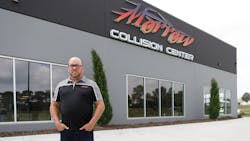Toward the end of his conversation with FenderBender, Dan Morrow reflected on some final words of wisdom based on his decades of experience in collision repair. What the owner of Morrow Collision Center in Lincoln, Nebraska, settled on was a personal philosophy that was completely validated by all his preceding words.
“I guess one thing that helps me as an owner is I'll turn any negative into a positive,” Morrow says. “It's just the way I've always been, the way I always think, if there's any kind of news or something that happens, and it's a negative, my mind immediately looks for the silver lining.”
Two landmark moments in the history of Morrow’s business illustrate this point. In 2001, as a young collision repair professional, Morrow took the leap to becoming an owner and signed a lease on his new facility. Twenty days later, 9/11 happened. Suddenly, Morrow was in his mid-20s navigating an upended global economy while also learning how to be a business owner.
But that early challenge didn’t derail Morrow’s trajectory, aided by his brother and general manager Tom, into building one of Lincoln’s most successful body shops. Fast forward to 2020 and Morrow was putting the finishing touches on a brand-new, state-of-the-art facility, a move Morrow acknowledged was risky. Two weeks after the ribbon-cutting, the COVID-19 pandemic took hold of the United States.
It's a good thing Morrow is adept at finding a silver lining. His business has not only continued to thrive, but is a responsible, valued member of the Lincoln community and a place his employees love to work. It’s hard not to cite a Ted Lasso-like positivity and steadfast belief that things will work out as major reasons for Morrow’s success. For the business he’s built, the ways he gives back, and the ways he pays it forward, Morrow is our choice for this year’s FenderBender Award.
Meant to Be
Morrow was thinking about cycle times before he even knew what they were. As a boy, he loved assembling car models, recalling Christmases rushing up to his room with his new prize and laying out all the pieces on his desk. An early adopter of OEM procedures, he paid close attention to the instructions and put the cars together as fast as he could. He even used his desk lamp to make the paint dry faster.
One could say it was all meant to be.
“I don't know why that was fun for me to do it like that,” says Morrow, now 46. “But I was basically doing, like, efficient auto collision repair up there on my desk, and I didn't even think about it.”
Morrow’s mother recalls him making car noises at 6 months old, so cars have always been in his blood. He and his father restored Morrow’s first car, a 1957 Ford Fairlane purchased when he was 14. The body work they left to professionals and a shop that Morrow would eventually work at in high school. After graduating in 1995, he attended Southeast Community College in Milford, Nebraska, with some work experience already under his belt. He chose to stick with collision repair because he enjoyed technology and foresaw the advancing computerization of vehicles.
After graduation, Morrow returned to work at his hometown body shop, where the owner was thinking of retiring and selling. A deal for Morrow to buy the shop didn’t work out, but an opportunity later arose to buy a shop in Lincoln. Morrow laughs now recalling the basic business plan he drew up to secure a bank loan of $3,000, knowing what little he did about owning a business.
“I still have that; it was just two sheets with hardly any information on them,” says Morrow. “I still have that and it's just laughable. Looking at what I thought it was going to take, and so I didn't really have any business sense going in, but I knew how to work real hard.”
Spark of Inspiration
Morrow says he doesn’t know how, but he and his brother Tom turned out to be naturally gifted at collision repair. Their business was successful—so successful that Morrow couldn’t help but think about growth. He’d seen body shops grow in stages: an expansion here, a new building there. But he wanted to skip all that.
The shop was successful, but Morrow had the feeling they could be working smarter. In another late night of painting cars, when he was almost falling asleep standing up, Morrow decided to examine where the shop could be more efficient. He grabbed a piece of masking paper and started to jot down areas where there was wasted time in the shop—time spent waiting in the parking lot, time spent waiting for a wash, and so on.
“That's kind of where the whole thought process started,” recalls Morrow. “Tom and I started building a system, basically we spent the next eight years thinking about our processes, coming up with ideas on how to change, how to create the most perfect process that we could and basically cut out all the wasted time.”
As Morrow says, it took some time to develop a process that eliminated as much wasted time as possible in the shop. But as it was being formed, it became clear just how much time there was. And that process became the basis for how Morrow designed his new shop.
Cars at Morrow’s enter and exit the shop through one door. But inside, there is ample space, five lanes wide for disassembly and techs working off of rollable carts to keep things open and moving. Cars spend little time sitting and waiting, but if they have to, they won’t disrupt the flow of the shop and won’t take up space sitting in a parking lot.
“If a car gets disassembled and it's waiting for a suspension part or something, it can just sit there doesn't need to be moved,” explains Morrow. “We just keep lanes open past it. And so there are lifts strategically placed where cars can just sit in the shop and wait for parts; they never have to go outside. Technicians can keep busy and go right on to the next vehicle.”
A Lincoln Landmark
When Morrow was starting to plan for a new building, he did his homework. He looked at car counts for traffic and where the growing parts of the city were. In his studies, he learned that not that many people had heard of the shop. And that was just fine by Morrow.
“We were able to keep it a secret that we were looking to build this big building for eight years,” says Morrow. “And it didn't start getting out until it was in the permit process through the city. And so finally people started to hear about it.”
It was hard to miss the building when it opened. It covered more than 26,000 square feet, tilt-up concrete and glass. Morrow describes it as his “dream shop.” After more than three years of operations, Morrow has some tweaks in mind, but overall thinks, “We hit it out of the park on this building design.”
One of the ways Morrow got the word out about the shop was through community involvement. The shop doesn’t have a public relations director—the position is known as the community impact director. And they keep the shop plenty busy.
“We try to constantly think,” says Morrow, “what can we do here to get the community involved?”
The events Morrow’s have hosted vary widely, from a “trunk or treat” event this past Halloween to an Easter egg hunt for kids in the spring. The turnouts have surprised even Morrow. He expected roughly 400 people last Halloween, but a review of the security camera footage showed approximately 1,300 people coming through the doors.
That’s good marketing, showcasing the shop to that many potential customers. But the community obviously benefits as well. Besides the planned community events, the shop also has conference room space available to rent, and even hosts yoga on weekend mornings with light streaming in through the shop’s garage doors.
“Anytime that an employee, or a friend of an employee, anybody wants to use the space for their birthday party or something, we usually don't charge them,” says Morrow. “We just let them use that. I figure if they're in here, you know, they're going to be our customer after that.”
Morrow’s belief that things ultimately work out has been justified over and over in his career. Most often that’s been due to talent and hard work—making things work out rather than hoping so. But a little luck along the way always helps.
Morrow recalls one story from when he was starting his first shop, and he had just $3,000 to spend on a paint booth. Quotes he was getting were more like $40,000. Morrow’s then-wife was worried that they were in over their heads and it wasn’t going to work out.
“I was just like, what, what are you talking about? We will figure this out. Everything will work out,” Morrow recalls.
And sure enough, days later, a contact called who was selling his shop and looking to liquidate his equipment, including a paint booth. The price: $2,500.
“That's exactly how everything has always fallen into place for us,” says Morrow. “And I don't think it's luck. I think it's looking for that silver lining and always keeping a positive attitude. And loving what you do.”
About the Author
Todd Kortemeier
Todd Kortemeier is former editor of FenderBender magazine and started writing as a contributor in 2024.

